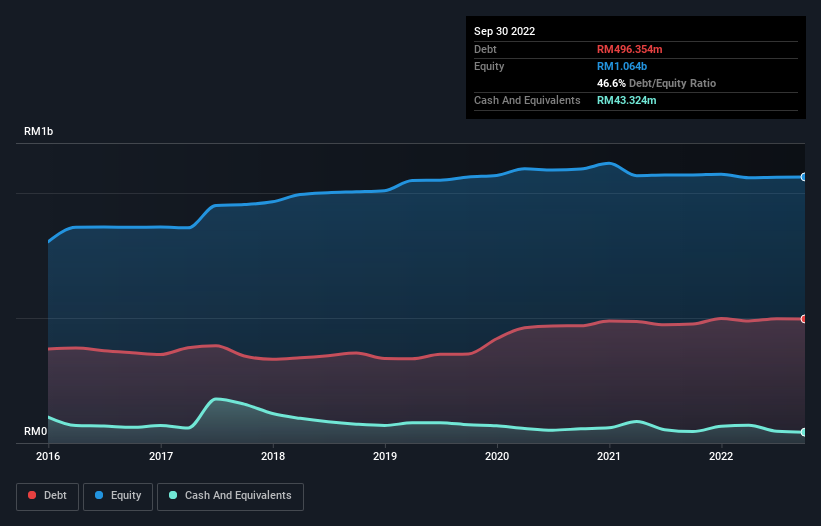- Malaysia
- /
- Real Estate
- /
- KLSE:ASIAPAC
These 4 Measures Indicate That Asian Pac Holdings Berhad (KLSE:ASIAPAC) Is Using Debt Extensively

Legendary fund manager Li Lu (who Charlie Munger backed) once said, 'The biggest investment risk is not the volatility of prices, but whether you will suffer a permanent loss of capital.' So it seems the smart money knows that debt - which is usually involved in bankruptcies - is a very important factor, when you assess how risky a company is. As with many other companies Asian Pac Holdings Berhad (KLSE:ASIAPAC) makes use of debt. But the more important question is: how much risk is that debt creating?
When Is Debt A Problem?
Debt assists a business until the business has trouble paying it off, either with new capital or with free cash flow. If things get really bad, the lenders can take control of the business. However, a more common (but still painful) scenario is that it has to raise new equity capital at a low price, thus permanently diluting shareholders. Of course, plenty of companies use debt to fund growth, without any negative consequences. When we think about a company's use of debt, we first look at cash and debt together.
View our latest analysis for Asian Pac Holdings Berhad
What Is Asian Pac Holdings Berhad's Net Debt?
The image below, which you can click on for greater detail, shows that at September 2022 Asian Pac Holdings Berhad had debt of RM496.4m, up from RM475.7m in one year. However, it also had RM43.3m in cash, and so its net debt is RM453.0m.

How Strong Is Asian Pac Holdings Berhad's Balance Sheet?
According to the last reported balance sheet, Asian Pac Holdings Berhad had liabilities of RM258.0m due within 12 months, and liabilities of RM709.6m due beyond 12 months. Offsetting these obligations, it had cash of RM43.3m as well as receivables valued at RM83.2m due within 12 months. So its liabilities total RM841.1m more than the combination of its cash and short-term receivables.
This deficit casts a shadow over the RM156.3m company, like a colossus towering over mere mortals. So we'd watch its balance sheet closely, without a doubt. After all, Asian Pac Holdings Berhad would likely require a major re-capitalisation if it had to pay its creditors today.
We use two main ratios to inform us about debt levels relative to earnings. The first is net debt divided by earnings before interest, tax, depreciation, and amortization (EBITDA), while the second is how many times its earnings before interest and tax (EBIT) covers its interest expense (or its interest cover, for short). This way, we consider both the absolute quantum of the debt, as well as the interest rates paid on it.
Asian Pac Holdings Berhad shareholders face the double whammy of a high net debt to EBITDA ratio (42.6), and fairly weak interest coverage, since EBIT is just 0.54 times the interest expense. The debt burden here is substantial. However, the silver lining was that Asian Pac Holdings Berhad achieved a positive EBIT of RM8.9m in the last twelve months, an improvement on the prior year's loss. There's no doubt that we learn most about debt from the balance sheet. But it is Asian Pac Holdings Berhad's earnings that will influence how the balance sheet holds up in the future. So if you're keen to discover more about its earnings, it might be worth checking out this graph of its long term earnings trend.
But our final consideration is also important, because a company cannot pay debt with paper profits; it needs cold hard cash. So it's worth checking how much of the earnings before interest and tax (EBIT) is backed by free cash flow. Over the last year, Asian Pac Holdings Berhad actually produced more free cash flow than EBIT. That sort of strong cash conversion gets us as excited as the crowd when the beat drops at a Daft Punk concert.
Our View
On the face of it, Asian Pac Holdings Berhad's interest cover left us tentative about the stock, and its level of total liabilities was no more enticing than the one empty restaurant on the busiest night of the year. But on the bright side, its conversion of EBIT to free cash flow is a good sign, and makes us more optimistic. We're quite clear that we consider Asian Pac Holdings Berhad to be really rather risky, as a result of its balance sheet health. For this reason we're pretty cautious about the stock, and we think shareholders should keep a close eye on its liquidity. When analysing debt levels, the balance sheet is the obvious place to start. But ultimately, every company can contain risks that exist outside of the balance sheet. For instance, we've identified 5 warning signs for Asian Pac Holdings Berhad (2 are significant) you should be aware of.
If you're interested in investing in businesses that can grow profits without the burden of debt, then check out this free list of growing businesses that have net cash on the balance sheet.
New: Manage All Your Stock Portfolios in One Place
We've created the ultimate portfolio companion for stock investors, and it's free.
• Connect an unlimited number of Portfolios and see your total in one currency
• Be alerted to new Warning Signs or Risks via email or mobile
• Track the Fair Value of your stocks
Have feedback on this article? Concerned about the content? Get in touch with us directly. Alternatively, email editorial-team (at) simplywallst.com.
This article by Simply Wall St is general in nature. We provide commentary based on historical data and analyst forecasts only using an unbiased methodology and our articles are not intended to be financial advice. It does not constitute a recommendation to buy or sell any stock, and does not take account of your objectives, or your financial situation. We aim to bring you long-term focused analysis driven by fundamental data. Note that our analysis may not factor in the latest price-sensitive company announcements or qualitative material. Simply Wall St has no position in any stocks mentioned.
About KLSE:ASIAPAC
Asian Pac Holdings Berhad
An investment holding company, engages in the property development and investment businesses in Malaysia.
Moderate and good value.
Similar Companies
Market Insights
Community Narratives



